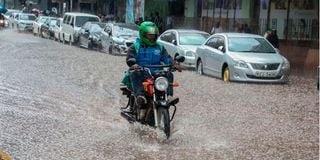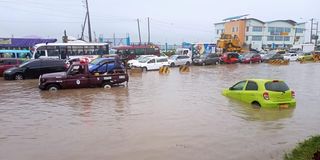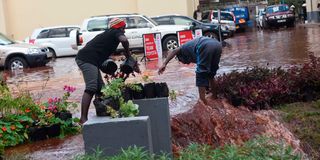Premium
Expect floods in Nairobi and Coast, weatherman warns

A flooded section of Kenyatta Avenue in Nairobi following heavy rains in this picture taken on March 23, 2023.
The Kenya Meteorological Department has issued an urgent warning to residents of Nairobi, Western and the Coast to expect heavy rainfall between November 2 and 5.
The rains, accompanied by strong winds, are expected to subside by November 6.
Residents of hotspot areas have been advised to be on the lookout for possible flooding, structural damage and landslides.

Vehicles that were submerged on the Mombasa-Changamwe road after a heavy downpour.
“Residents in all the mentioned areas are advised to be on the lookout for potential floods. Flood waters may appear in places where it has not rained heavily, especially downstream. Residents are advised to avoid driving through or walking in moving water or open fields and not to shelter under trees and near grilled windows when raining to minimise exposure to lightning,” it said.
“The strong winds may blow off roofs, uproot trees and cause structural damage. People in landslide prone areas, especially over the slopes of the Aberdare ranges, Mt Kenya and other hilly areas in the western region, should be vigilant,” it added.
According to the El Nino Response Plan, livestock losses are expected to be a major consequence of the flooding, with 828,667 animals at risk of death due to flooding in Samburu and the destruction of more than 50 per cent of pasture in Mandera.

Workers diverting rain water at a flooded petrol station along Limuru Road on October 17, 2023.
The Agency for Technical Cooperation and Development (ACTED) will provide essential supplementary feeds such as hay, range cubes, salt licks and nutritious pellets to affected livestock.
“Mass treatment and vaccination: In response to anticipated epidemics of vector-borne and water-borne diseases, such as tryps and diarrhoea that will affect a significant proportion of livestock in Samburu, Mandera and Wajir, ACTED will provide logistical support to the affected counties for mass screening, deworming, vaccination and treatment of affected animals,” the organisation said.
The response plan also shows that despite significant damage in flood-prone areas – 10,000 farmers are expected to lose their crops in Mandera – improved rainfall will generally lead to increased agricultural production, particularly of legumes and vegetables.

A trailer drives through a flooded section of the Nakuru-Eldoret highway on November 2, 2023.
ACTED will therefore provide certified seeds and other agricultural inputs to vulnerable agro-pastoral communities to support agricultural productivity.
However, it shows that the floods will exacerbate food insecurity, as many crops will be lost and food prices are likely to rise.
ACTED's strategy to mitigate the impact on vulnerable households is based on the provision of cash assistance to increase the purchasing power of affected households until the end of January 2023.

Workers clearing a flooded section of UN Avenue in Gigiri, Nairobi on October 17, 2023.
“More than 150,000 people are expected to be affected by vector-borne diseases in Samburu County. Acted will procure essential non-food items (NFIs) such as aqua tabs, buckets, jerrycans, mosquito nets and dignity kits, to be distributed at designated hotspots,” it said.
The plan also states that early warning systems provided by the Kenya Meteorological Department and the National Drought Management Authority (NDMA) need to be further developed at the local level to reach vulnerable households, especially female-headed households, which on average have less access to information and communication devices.
“Strengthening early warning systems at county level and improving the diffusion of information could help counties develop and effectively implement early action protocols,” the report says.






